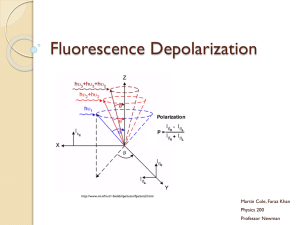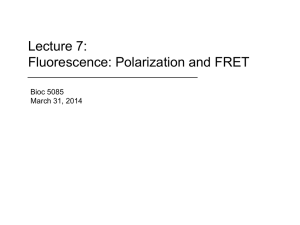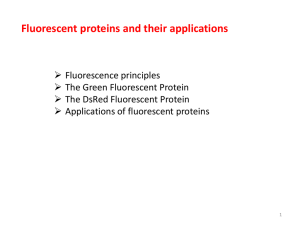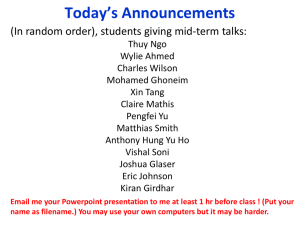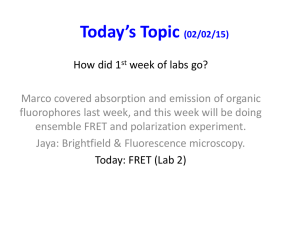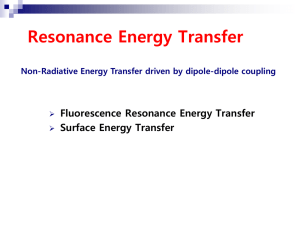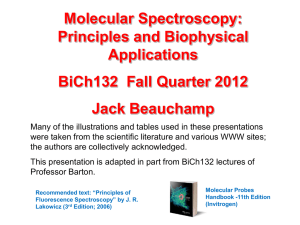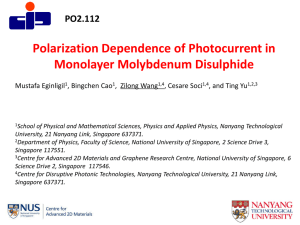k 2
advertisement
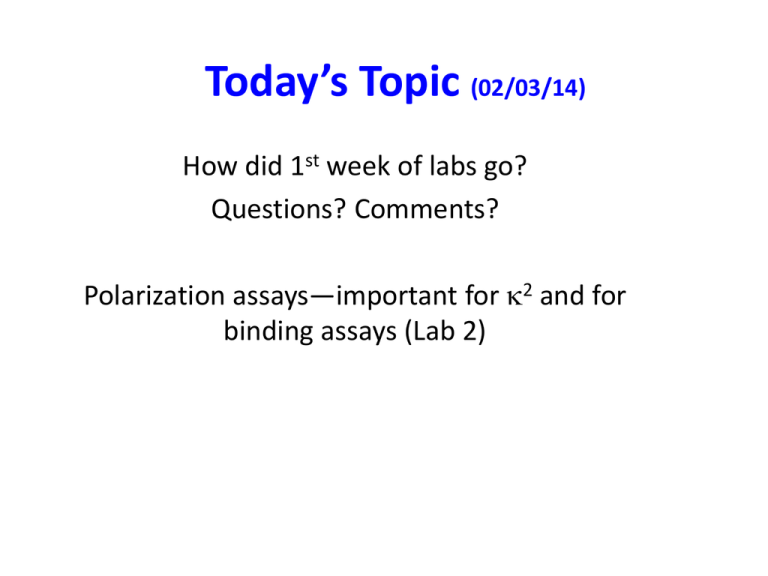
Today’s Topic (02/03/14) How did 1st week of labs go? Questions? Comments? Polarization assays—important for k2 and for binding assays (Lab 2) Fluorescence Polarization Important for binding assays Also important for k2. 1. Dyes have a transition absorption dipole moment If light is polarized in direction of dipole, , will absorb light; if polarized perpendicular to light, it won’t absorb it. Signal proportional to sinQa, Qa is angle between light vector and dipole moment vector. 2. Once molecule is excited, then has probability of emitting, via an emission dipole moment, (which tends to be aligned with the absorption dipole moment). The probability that it will make it through the analyzer is sinQe, Qe is angle between emission dipole vector and analyzer. Coordinate system Excited fluorophores How to measure FP perpendicular ( Polarization Anisotropy (0 to 0.5) (0 to 0.4) parallel ( ) Polarization & Anisotropy: Just slightly different forms Generally use Anisotropy because of simpler forms when time-dependent. Also simpler when have multiple components: A = SciAi where ci is the mole fraction of the ith component. ) Polarization vs. Anisotropy Denominators with P, A Polarization P defined by analogy with dichroism ratio Anisotropy The denominator of Anisotropy is simply the total light that would be observed if no polarizers were used. (Come in along x-axis.) Call Iz = I|| Call Iy = I Non-polarized light (along x-axis) Break into Iz, Iy. Call Ix = I Ix+ Iy + Iz = 2 I + I|| Anisotropy is a more useful form for experimental data on complex systems Generally use Anisotropy because of simpler forms when time-dependent. Also simpler when have multiple components: A = SciAi where ci is the mole fraction of the ith component. Polarization Can measure the average polarization (easiest), Or the time-dependent (nanosecond lifetime) polarization (most informative) http://www.lifetechnologies.com/us/en/home/references/ molecular-probes-the-handbook/technical-notes-andproduct-highlights/fluorescence-polarization-fp.html FP set-up in a microscope Anisotropy Perrin equation (Perrin, 1926): A0/A=1+6Dt, including the rotational diffusion coefficient (D), fluorescence lifetime (t) and, more significantly, the fundamental anisotropy (A0) which varies according to wavelength (Lakowicz, 1999; Weber & Shinitzky, 1970). http://www.urmc.rochester.edu/imaging/research/tho mas-foster/fluorescence-anisotropy.aspx FP applied to binding Competition monitored via FP Homogeneous Assays, no labeling competitors http://labs.fhcrc.org/hahn/Methods/biochem_meth/ beacon_fluorescence_guide.pdf Competition monitored by FP Competitive Binding monitored by FP Anything that adds mass can be used in FP: Homogeneous Assay http://www.iss.com/resources/research/technical_notes/PC 1_FP.html Examples (from Life Technologies) Examples of FP (in crystals) GFP Crystals: Fluorescence polarization of needle-shaped GFP crystals revealed by false color. The fluorescence of the crystals is strongly polarized parallel to the needle axis. Hue in this color image represents the polarization orientation with maximum fluorescence. Purified GFP extracted from the jellyfish Aequorea was generously provided by Osamu Shimomura and crystals were prepared by Naoki Noda, following the description given by Inoué et al. (Inoue, S., O. Shimomura, M. Goda, M. Shribak and P. T. Tran. 2002. Fluorescence polarization of green fluorescence protein. Proc Natl Acad Sci U S A 99: 4272-7.) http://openpolscope.org/pages/Fl uorescence_Polarization.htm Example of living cell FP Septin-GFP constructs in MDCK Cell: Fluorescence image of a living cell (MDCK) expressing septin molecules linked to green fluorescent protein (GFP). The image was recorded with the Fluorescence LC-PolScope which reveals the polarized fluorescence of septin fibers in false color. Each hue is associated with a different orientation of the GFP dipoles, which in turn reflect the fiber orientation, as septin-GFP molecules are locked into the fiber assembly. The white color of the fluorescence from the cytosol, on the other hand, reveals the lack of a common alignment of septin-GFP molecules suspended in the cytosol. Credit: Bradley DeMay and Amy Gladfelter, Dartmouth College. http://openpolscope.org/pages/ Fluorescence_Polarization.htm Anisotropy and time-dependence http://www.ursabioscience.com/technology/particle-probes Anisotropy and time-dependence For a spherical particle: Rotational correlation time: tc = 1/6Drot = Vhh/kBT Where h = viscosity: Vh = hydrated molecular volume A(t) = Ao exp(-t/tc) Hydrated specific volume = 1g/ml Hydrated volume = M/No (Divide by Avogado’s #) Roughly tc = 1 nsec for each 2,400 daltons of protein molecular weight and for globular nucleic acids k2 and Ro in FRET 1 E 1 ( R / R0 )6 Ro = 0.21( JqD n k -4 2 ) 1 6 in Angstroms • J is the normalized spectral overlap of the donor emission (fD) and acceptor absorption (eA) . Does donor emit where acceptor absorbs? • qD is the quantum efficiency (or quantum yield) for donor emission in the absence of acceptor (qD = number of photons emitted divided by number of photons absorbed). • n is the index of refraction (1.33 for water; 1.29 for many organic molecules). • k2 is a geometric factor related to the relative orientation of the transition dipoles of the donor and acceptor and their relative orientation in space. Very important; often set = 2/3. k2 : Orientation Factor The spatial relationship between the DONOR emission dipole moment and the ACCEPTOR absorption dipole moment y qD D R z qDA q A A (0< k2 >4) k2 often = 2/3 x where qDA is the angle between the donor and acceptor transition dipole moments, qD (qA) is the angle between the donor (acceptor) transition dipole moment and the R vector joining the two dyes. k2 ranges from 0 if all angles are 90°, to 4 if all angles are 0°, and equals 2/3 if the donor and acceptor rapidly and completely rotate during the donor excited state lifetime. k 2 is usually not known and is assumed to have a value of 2/3 (Randomized distribution) This assumption assumes D and A probes exhibit a high degree of rotational motion Can measure whether donor & acceptor randomize by looking at polarization. A range of k2 leads to range of E, Ro The maximum range of k2 is given by k2max = 2/3(1+2.5Ad+2.5Aa) k2min = 2/3(1-1.25Ad-1.25Aa) where Ad and Aa are the anisotropy of AF488 (donor) and AF568 (acceptor), respectively. Dale et al, Biophysical J. 1979 The End Extra Slides We briefly mentioned how Green Fluorescent Protein (GFP) can be perfectly labeled in vivo because it is placed in a cell by genetic means, i.e. through DNA attached to another protein’s DNA (like kinesin-GFP fusion, shown), and then the DNA is transfected inside the cell. GFP now comes in many colors. Green Fluorescent Protein GFP – genetically encoded dye (fluorescent protein) (Motor) protein GFP Attach DNA for GFP onto end of DNA encoding for protein. Get DNA inside cell and DNA process takes over…perfectly Came from Jelly Fish Inserted in Tobacco (plant) & in Monkeys (animals) Kinesin – GFP fusion Lots of FP mutants—different colors Genetically encoded perfect specificity. Different Fluorescent Proteins Absorption Fluorescence mHoneydew, mBanana, mOrange, tdTomato, mTangerine, mStrawberry, mCherry Shaner, Tsien, Nat. Bio., 2004
